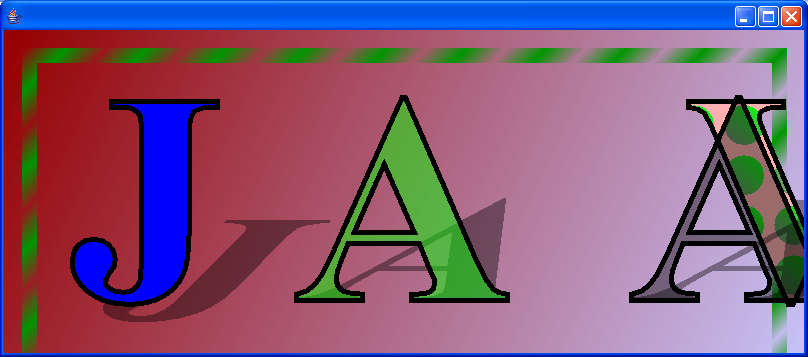Paints

/*
* Copyright (c) 2000 David Flanagan. All rights reserved.
* This code is from the book Java Examples in a Nutshell, 2nd Edition.
* It is provided AS-IS, WITHOUT ANY WARRANTY either expressed or implied.
* You may study, use, and modify it for any non-commercial purpose.
* You may distribute it non-commercially as long as you retain this notice.
* For a commercial use license, or to purchase the book (recommended),
* visit http://www.davidflanagan.com/javaexamples2.
*/
import java.awt.BasicStroke;
import java.awt.Color;
import java.awt.Font;
import java.awt.GradientPaint;
import java.awt.Graphics;
import java.awt.Graphics2D;
import java.awt.Paint;
import java.awt.Rectangle;
import java.awt.Shape;
import java.awt.TexturePaint;
import java.awt.font.GlyphVector;
import java.awt.geom.AffineTransform;
import java.awt.image.BufferedImage;
import java.awt.event.WindowAdapter;
import java.awt.event.WindowEvent;
import javax.swing.JFrame;
import javax.swing.JPanel;
/** A demonstration of Java2D transformations */
public class Paints extends JPanel {
static final int WIDTH = 800, HEIGHT = 375; // Size of our example
public String getName() {
return "Paints";
}
public int getWidth() {
return WIDTH;
}
public int getHeight() {
return HEIGHT;
}
/** Draw the example */
public void paint(Graphics g1) {
Graphics2D g = (Graphics2D) g1;
// Paint the entire background using a GradientPaint.
// The background color varies diagonally from deep red to pale blue
g.setPaint(new GradientPaint(0, 0, new Color(150, 0, 0), WIDTH, HEIGHT,
new Color(200, 200, 255)));
g.fillRect(0, 0, WIDTH, HEIGHT); // fill the background
// Use a different GradientPaint to draw a box.
// This one alternates between deep opaque green and transparent green.
// Note: the 4th arg to Color() constructor specifies color opacity
g.setPaint(new GradientPaint(0, 0, new Color(0, 150, 0), 20, 20,
new Color(0, 150, 0, 0), true));
g.setStroke(new BasicStroke(15)); // use wide lines
g.drawRect(25, 25, WIDTH - 50, HEIGHT - 50); // draw the box
// The glyphs of fonts can be used as Shape objects, which enables
// us to use Java2D techniques with letters Just as we would with
// any other shape. Here we get some letter shapes to draw.
Font font = new Font("Serif", Font.BOLD, 10); // a basic font
Font bigfont = // a scaled up version
font.deriveFont(AffineTransform.getScaleInstance(30.0, 30.0));
GlyphVector gv = bigfont.createGlyphVector(g.getFontRenderContext(),
"JAV");
Shape jshape = gv.getGlyphOutline(0); // Shape of letter J
Shape ashape = gv.getGlyphOutline(1); // Shape of letter A
Shape vshape = gv.getGlyphOutline(2); // Shape of letter V
// We're going to outline the letters with a 5-pixel wide line
g.setStroke(new BasicStroke(5.0f));
// We're going to fake shadows for the letters using the
// following Paint and AffineTransform objects
Paint shadowPaint = new Color(0, 0, 0, 100); // Translucent black
AffineTransform shadowTransform = AffineTransform.getShearInstance(
-1.0, 0.0); // Shear to the right
shadowTransform.scale(1.0, 0.5); // Scale height by 1/2
// Move to the baseline of our first letter
g.translate(65, 270);
// Draw the shadow of the J shape
g.setPaint(shadowPaint);
g.translate(15, 20); // Compensate for the descender of the J
// transform the J into the shape of its shadow, and fill it
g.fill(shadowTransform.createTransformedShape(jshape));
g.translate(-15, -20); // Undo the translation above
// Now fill the J shape with a solid (and opaque) color
g.setPaint(Color.blue); // Fill with solid, opaque blue
g.fill(jshape); // Fill the shape
g.setPaint(Color.black); // Switch to solid black
g.draw(jshape); // And draw the outline of the J
// Now draw the A shadow
g.translate(75, 0); // Move to the right
g.setPaint(shadowPaint); // Set shadow color
g.fill(shadowTransform.createTransformedShape(ashape)); // draw shadow
// Draw the A shape using a solid transparent color
g.setPaint(new Color(0, 255, 0, 125)); // Transparent green as paint
g.fill(ashape); // Fill the shape
g.setPaint(Color.black); // Switch to solid back
g.draw(ashape); // Draw the outline
// Move to the right and draw the shadow of the letter V
g.translate(175, 0);
g.setPaint(shadowPaint);
g.fill(shadowTransform.createTransformedShape(vshape));
// We're going to fill the next letter using a TexturePaint, which
// repeatedly tiles an image. The first step is to obtain the image.
// We could load it from an image file, but here we create it
// ourselves by drawing a into an off-screen image. Note that we use
// a GradientPaint to fill the off-screen image, so the fill pattern
// combines features of both Paint classes.
BufferedImage tile = // Create an image
new BufferedImage(50, 50, BufferedImage.TYPE_INT_RGB);
Graphics2D tg = tile.createGraphics(); // Get its Graphics for drawing
tg.setColor(Color.pink);
tg.fillRect(0, 0, 50, 50); // Fill tile background with pink
tg.setPaint(new GradientPaint(40, 0, Color.green, // diagonal gradient
0, 40, Color.gray)); // green to gray
tg.fillOval(5, 5, 40, 40); // Draw a circle with this gradient
// Use this new tile to create a TexturePaint and fill the letter V
g.setPaint(new TexturePaint(tile, new Rectangle(0, 0, 50, 50)));
g.fill(vshape); // Fill letter shape
g.setPaint(Color.black); // Switch to solid black
g.draw(vshape); // Draw outline of letter
// Move to the right and draw the shadow of the final A
g.translate(160, 0);
g.setPaint(shadowPaint);
g.fill(shadowTransform.createTransformedShape(ashape));
g.fill(ashape); // Fill letter A
g.setPaint(Color.black); // Revert to solid black
g.draw(ashape); // Draw the outline of the A
}
public static void main(String[] a) {
JFrame f = new JFrame();
f.addWindowListener(new WindowAdapter() {
public void windowClosing(WindowEvent e) {
System.exit(0);
}
});
f.setContentPane(new Paints());
f.setSize(800,375);
f.setVisible(true);
}
}
Related examples in the same category